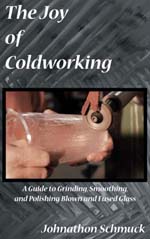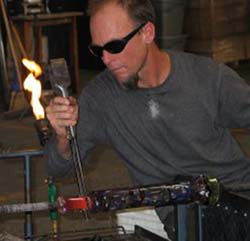Mr.
Turner was born and raised in Northern California. As an only child,
Mr Turner often lost himself in drawing, invention, and just plain
‘making things’.
At an early age, his family exposed him to the joys of the outdoors,
and he spent many summers in the high mountains of Colorado with his
uncle, Phil Turner
and his cousin, John Turner. When starting university studies at
UC Santa Cruz in 1981, this love of the outdoors was translated into
a study of Geology
for Mr. Turner. Funny things happen, and an interest in studying
the earth flipped into a desire to make art when Mr. Turner began
to explore the visual
dimension of the science of Geology. Despite attaining a Bachelor’s
degree in Earth Science (aka Geology), he started to paint and to
‘make things’ again while
working as a tofu novice in Santa Cruz.
After one year, Mr Turner
was tired of the wetness of paint, of clay, and of tofu, so he enrolled
in Mary White’s glass class at San Jose State. Three years
of class there led him to an apprenticeship and a job in Santa Fe,
New Mexico, with Flo Perkins. Once in Santa Fe, Mr Turner was also
able to work with
Charles Miner, Peet Robison, and Mark Stephenson. After three and
one half years in New Mexico, it was time for Mr Turner to open his
own studio
but while being a teaching assistant for a glassblowing course at
Haystack Mountain School of Crafts in Maine in the summer of 1994,
he was provided
with the impetus attend graduate school.
Mr. Turner moved
to Rochester, New York, for graduate study in glass at the School
for American Crafts, RIT, the Rochester Institute of Technology.
During this time, he was written up in the New Glass Review #17 by
Arthur Danto, in regards to a ketchup-bottle ‘Hourglass’.
Mr Turner was also
elected as Student Representative to the Board of Directors of GAS,
the Glass Art Society. His MFA show opened just one month before Mr.
Turner
had to put together the Education Center & Miniature Golf Tournament
for the 1997 GAS conference in Tucson, Arizona. Funny things happen,
and not
10 minutes after obtaining the last signature of approval on his MFA
thesis at RIT, Mr Turner was informed that he won a Fulbright Scholarship
to attend the Canberra School of
Art in Australia, for post-graduate study and a candidacy for
a Master’s degree there. He accepts.
Australia starts out as
a challenge. Though the atmosphere is more congenial than that found
back in the ‘states, the Uni in Australia runs a much tighter
ship,
and the rigor of the program is very evident in the Glass Workshop.
Mr Turner’s supervisor, Stephen Procter, would help Mr. Turner
see and understand every place that his work could be improved, and
thus was able to assist in the betterment of the glasswork. During
this time, which included a trip to Venice, Italy, to attend the opening
of the Venezia Aperto Vetro show in 1998, of which Canberra School
of Art was the only school invited to show,
Mr Turner also becomes a member of a team for Klaus Moje, turning
Mr. Moje’s fused flat panels into blown cylinders in a revolutionary
glassmaking process known as the Roll
Up.
Funny things still happen,
and the Roll Up turns out to be Mr Turner’s salvation. Not
only is it a comprehensive and vital new technique of glassmaking,
involving fusing, blowing, wheel cutting and other cold-finishing
processes, the Roll Up also provides Mr Turner with possibility of
executing work directly
related to the aesthetic of his studies in geology a decade earlier.
In August of 1999, this course of action leads to Mr. Turner’s
first solo show at the
Beaver Galleries in Australia, entitled ‘Unconformities’,
which dealt with the expression in glass of the meeting and juxtaposition
of two different types
of rock strata within the context of a vessel. As an exhibition, it
was a huge success.
Visa and workplace issues
led Mr. Turner to a three-month residency at Gloria Hot Glass in
Auckland, New Zealand, with Ruth Allen, and a chance to
see in the new Millennium at one of the closest points to the Dateline
on the east coast of the Great Barrier Island of New Zealand. He then
set out
to return to America via Viet Nam, Laos, Thailand, Nepal, Bhutan,
Sikkim, India (and a visit to the glass-producing city of Firozabad),
Egypt, and the UK.
But nothing in his travels prepared Mr Turner for his return in mid
2000 to Santa Cruz amidst the “dot-com boom”, so he fled
to Chico, California, to build
his Roll Up studio.
Fifteen months was enough
in Chico. Funny things happen, and on the very first of April in 2002,
Mr Turner moved his operation to Santa Cruz, only thirty
minutes from where his Dad lives in Los Gatos, one minute from his
favorite surf break, Mitchell’s Cove, and 30 seconds from the
infamous Derby Skate Park.
In 2003, Mr Turner taught Roll Up classes in Corning, New York; Montreal,
Canada; and La Granja, Spain. His work has been subsequently inducted
into the Museo del Vidrio in La Granja, Spain. Mr. Turner taught
there again in 2005, 2007, and 2009, and he has toured through Spain
and Holland afterwards,
taking in the remarkable graffiti murals in those parts. In looking
at the European graffiti and combining that with the ‘board’
culture of Santa Cruz, Mr Turner began a series of glass skateboard
decks with text integrated into the form. Somehow, this work lead
to a book contract for a text about grinding glass, and in May of 2009, Mr Turner’s book, The
Joy of Coldworking, was published by Warm Glass.
top
of page
|

